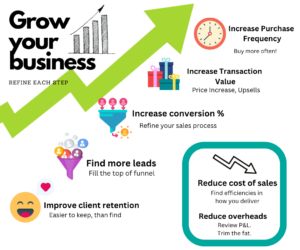What 20% of results are driving 80% of the success in your business?
Which areas are actually just COSTING you money and need to be stopped?
We want to double down on our strengths and minimise our weaknesses.
This article is for anyone that does project-based work.
We are trying to avoid the X2 main problems with most projects:
Undercharging: not scoping or pricing the job correctly
Overservicing: spending too much time on an individual project/client
We need to work out which of our:
- Service offerings
- Clients
- Team members
Are really driving the success of our business.
The service /clients /staff that give us the least headaches for the most profit.
Below we give you two ways to find which projects are profitable
- The simple way:
The basic way is to track total revenue and then all associated costs to that project. E.g a Web design job with $10k revenue less $7k in direct costs related to this job = 3k or 30%.
30% Gross Margin which is a good baseline goal for an agency.
Gross margin is before you have paid for all your company’s overheads like rent, internet, etc.
- Tracking Estimates VS Reality
NB: this method relies on you tracking where your team spends their time. Try Harvest or similar to get data on where their time is spent.
Reality always comes knocking for us eventually.
This takes into account the quoting and estimating process, and then compares it to the actual result.
The firms that can make this connection between estimate and reality are the ones that succeeded.
Often the sales teams are leading the quoting which causes a disconnect and causes major profitability issues.
It makes sure you LEARN from your mistakes when quoting for future projects.
Pricing
A HUGE part of profitability is pricing the job correctly.
Discounting should be avoided, as this directly eats into your margins.
Agencies can use a range of pricing models such as value-based, Fixed Fee, Hourly rate, or even performance-based (especially in the Google Ads world).
Doing custom prices depending on jobs can lead to a mixture of profitability in jobs so we need to track separately to find the hidden problems.
Estimates VS Reality: an example
- Weighted average charge out rate: this is the hourly rate you price your project at
e.g $250 per hour X20 hours = $5000 Job
- Actual Charge out Rate: Time for a reality check.
Each month when you are doing your hourly review of finances (you have one scheduled right?!) you need to check how each project has gone:
In this example let’s assume the job took 25 hours, instead of your budgeted 20.
Actual Charge out rate = Sales Price / Billable hours ACTUALLY worked
$5000 / 25 Hours = $200hr Average bill rate.
Average Billable Rate = $200
BUT we estimated $250?!
We are making on average $50 less on each hour than we budgeted.
Why this matters
Over 20 hours X$50 = $1000
This is the hidden killer of profitability.
You can’t see this $1000 on your Profit & Loss, as your staff might be paid a set amount per month.
It’s the OPPORTUNITY COST you have lost: those staff should have been working on another client, increasing your overall capacity.
This is when you look at whether you are undercharging, incorrectly estimating time or perhaps a staffing issue.
THE GOAL: is to get your Charge out Rate = Actual rate.
You are estimating correctly, and holding the team accountable to stay on track on not overservice.
They might even flag when client requests are “out of scope” so you can suggest an upsell.
NB: If you are consistently doing fewer hours than budgeted make sure your quality of work is still maintained.
As you can see, comparing estimates VS actuals helps you compare apples to apples across each of your projects.
What to do with this data:
Maximize Strength: look for trends across your projects, why are certain jobs better than others? Is it a specific product? Or a superstar staff member? Find the reason and double down on it.
Minimize Weaknesses: What is causing the poor performance in certain jobs? Perhaps it’s scope creep or a poorly performing staff member who is doing work not suited to their strengths? This gives you a chance to track each job and dig deeper if needed.
Get in touch if you would like to learn more.




